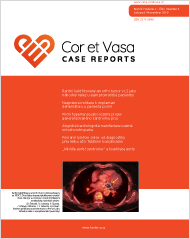 Cor et Vasa Case Reports
Cor et Vasa Case Reports
Svazek | Volume 2 • Číslo | Number 3
Listopad | November 2019
 Cor et Vasa Case Reports
Cor et Vasa Case Reports
Svazek | Volume 2 • Číslo | Number 3
Listopad | November 2019

D. Štulcová, H. Lubanda, R. Špunda, I. Vítková, P. Matras, J.C. Lubanda, A. Linhart
Cardiac calcified amorphous tumour (CAT) is a very rare nonneoplastic lesion, whose hallmark is extensive diffuse calcification. Depending on its location it can lead to blood flow obstruction or embolization of calcified parts of CAT. Besides calcified tumours (both malignant and benign) differential diagnosis includes calcified thrombi and extensive extrusion of mitral valve annular calcifications. Transthoracic echocardiography is often the first line method in diagnostic process, while CT is the best method to evaluate calcifications. Subsequent microscopic examination should identify the aetiology of the mass. In this case report we describe CAT which was incidentally found during echocardiography in a 70-year-old asymptomatic hypertensive female patient during preoperative evaluation. Transthoracic echocardiography revealed a calcified mobile 25 × 25 mm round-shaped structure in the left atrium which did not cause obstruction. Subsequent transoesophageal echocardiography showed that it was attached to the basis of the left atrial appendage. It seemed that there was some discontinuity in the calcified outer layer of the mass and some moving content in its centre. Computed tomography described a mass with a smooth continuous calcified surface, with homogenous central part and without postcontrast enhancement. Positron emission tomography ruled out metastatic disease. The tumour was later successfully surgically removed. Gross examination of the structure showed thick calcified peripheral layer and softer brownish-yellow tissue with fluid inside. Histopathologic examination described the lesion as a fibrotized calcified tumour.

B. Polová, R. Polášek, E. Borišincová, T. Roubíček
Incidence of Mahaim accessory pathway is very rare and may be a cause of the atrioventricular reentry tachycardia with broad QRS complex and left bundle branch block morphology. We present a case of a young man with coronary artery disease after myocardial infarction, where misdiagnosis of supraventricular tachycardia of the Mahaim type for ventricular tachycardia led to the implantation of a cardioverter-defibrillator with unfavorable complications (inadequate shocks). Electrophysiological examination revealed the presence of Mahaim accessory pathway and arrhythmia was treated by radiofrequency catheter ablation.

J. Vrtal, M. Branny, J. Mrózek
A malignant tumor is a rare cause of pulmonary hypertension; a correct diagnosis is however often difficult. Here, we present a case of a 77-year-old patient who was repeatedly hospitalized over a short period due to progressive dyspnea seemingly due to pneumonia and pulmonary hypertension and in whom only an autopsy revealed a true cause of the pulmonary hypertension – breast cancer with generalization into lungs.

J. Walder, P. Kupková, V. Kaučák, K. Novobílský
Mitochondrial disease is a heterogeneous group of systemic diseases that develop consequent to mutations in nuclear or mitochondrial DNA. The prevalence of inherited mitochondrial disease has been estimated to be greater than 1 in 5,000 births. Defect of mitochondrial energetic metabolism is typically manifested in a more pronounced manner in organs with higher metabolic requirements – in the brain, myocardium, liver, muscles and endocrine organs, therefore symptomatology is so colourful and cardiac disability is not specific. The typical cardiac manifestation of mitochondrial disease contains hypertrophic and dilated cardiomyopathy, arrhythmia – both bradyarrhythmia and tachyarrhythmia, and heart failure. The diagnosis of mitochondriopathies is simple in case of typical neurological and cardiac picture, but in most cases the clinical features are atypical and diagnosis is difficult to determine, as documented in the following case report. This case report describes the case of a young man, who was primarily hospitalized in Municipal Hospital Ostrava with decompensated hypertension and gradually further examinations and look into his detailed medical history led to the revelation of this rare diagnosis.

A. Madron, J. Dvořáček, T. Paleček
Primary cardiac tumors are a rare disease, their incidence is around 0.02% in adults. Only 25% of primary cardiac tumors are malign and, of these, most are sarcomas. Symptoms include loss of weight, loss of apetite, fatique, thromboembolism, heart failure or arrhythmias. Our case report describes a primary cardiac lymphoma from the right atrium and the right ventricle that presented with a small pulmonary embolism. Administration of the low molecular weight heparin led into a pericardial effusion followed by the cardiac tamponade requiring an urgent pericardiocentesis. Cardiac magnetic resonance imaging (MR) was crucial in the diagnostic process as the imaging modality making an initial diagnosis. Histologic examination from the endomyocardial biopsy demonstrated a diffuse large B-cell lymphoma. Total-body pozitrone emission tomography (PET) and bone marrow biopsy confirmed a localized cardiac tumor. The patient received a targeted chemotherapy which led to the complete regression of the tumor. However, five months after the last cycle of chemotherapy, the lymfoma relapsed in the posterior part of the right lateral brain ventricle and in the area of splenium corporis callosi. To rule out the tumor duplicity, a stereotactic brain biopsy was performed. Unfortunately, it was complicated with an intracerebral bleeding followed by the patient‘s death.

I. Šimková, R. Stříbrný, M. Černá, E. Čecháková, E. Kociánová, M. Táborský
Abstract We describe a case report of a 52-year-old patient with rare combination of two congenital aortic narrowings. First is the coarctation of the thoracic aorta (at the ligamentum arteriosum) combined with second, much less common aortic coarctation located in the distal thoracic and abdominal aorta. This pathology is often called “middle aortic syndrome”. Most of the patients are diagnosed within the first three decades of life. The presence of both forms of coarctation is unique, so is also the late onset of first symptoms. Paroxysmal atrial fibrillation with rapid ventricular response led to symptoms of visceral hypoperfusion. Arterial hypertension probably remained undiagnosed for a long time, because ventricular hypertrophy was present by the time of the diagnosis. After the diagnosis was confirmed, the sinus rhythm has been restored. Blood pressure remains within the normal limits. The patient is treated conservatively as he remains asymptomatic.